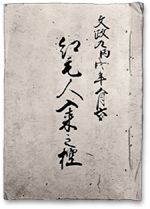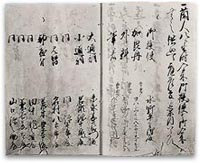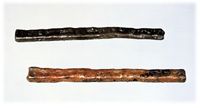Riemon Soga
(1572-1636)
In his youth, Riemon Soga mastered copper refining and coppersmithing in Sakai. In 1590, at the age of 19, he opened a copper refining and coppersmithing business in Kyoto under the name of Izumiya.
Riemon married Masatomo’s elder sister. All the members of Riemon’s family were devotees of the Nehan Sect and followers of Masatomo.
In those days, the technology of copper refining was in its infancy in Japan. Copper was exported without extracting the silver from the blister copper, enabling foreign merchants to gain additional profit.
From Europeans, Riemon heard about the principle of separating silver from copper using lead. With great perseverance, he eventually developed nanban-buki, a new refining technique for separating silver from blister copper. This was reportedly during the Keicho era (1596-1615). Riemon’s ingenuity helped Izumiya prosper, enhancing its position in the copper industry. Tradition has it that Riemon donated most of the copper used for the large statue of Buddha (which no longer exists) at Hoko-ji Temple in Higashiyama, Kyoto, and for the temple bell there bearing the inscriptions “Kokka Anko (May the state be peaceful and prosperous)” and “Kunshin Horaku (May the lord and his vassals be rich and full of happiness).” Incidentally, it is said that Tokugawa Ieyasu’s idiosyncratic interpretation of these inscriptions was one of the causes of the Osaka Fuyu no Jin (Winter Campaign of the Siege of Osaka).


